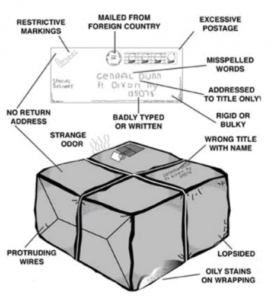Suspicious Package / Mail / Email
It is possible, although highly unlikely, that any faculty, staff, or student might someday receive or observe a suspicious package. The following section describes the common characteristics of a suspicious package and the various precautions to take if a suspicious package or email is received or discovered.
Suspicious letter or package characteristics
-

Suspicious Package Characteristics Origin – Postmark doesn’t match the city of the return address, name of sender is unusual or unknown, or no return address is given
- Postage – Excessive or inadequate postage
- Balance – the letter is lopsided or an unusually thick weight – the letter or package seems heavy for its size
- Contents – Stiffness or springiness of contents; protruding wires or components; oil on outer wrapping or envelope; feels like it contains powdery substance
- Smell – Particularly almond or other suspicious odors
- Writing – Handwriting of sender is not familiar or indicates a foreign style not normally received by recipient or cut-and-paste or run-on-block letters are used. Common words, names or titles are misspelled or special instructions like “fragile,” “confidential,” or “do not delay” are present. Title, but no name.
Additional characteristics if letter or package is a mail bomb
- Protruding wires or aluminum foil
- Strange odors or stains
- An unusual amount of tape
- Buzzing, ticking or a sloshing sound
- Irregular shape, soft spots or bulges
- Excessive weight for its size
- Letter bombs may feel rigid or appear uneven or lopsided
If you receive or find a threat or suspicious parcel or object
- Do not handle any more than is absolutely necessary
- Do not shake, bump or empty the contents of any suspicious item
- Isolate immediately
- Don’t open, smell, touch or taste. Treat it as potentially dangerous.
- Do not use cellular phones or walkie-talkies in the immediate vicinity of the parcel or object
- Notify 9-911 from Stanford University phones (911 from non-campus or cell phones), give the following information:
- Your name
- Telephone number
- Location of the parcel or object (using building, floor and room number, if possible)
- Description of the parcel or object
Note: Do not hang up until the dispatcher advises you to disconnect
- Promptly write down everything you can remember about receiving the letter or parcel, or finding the object, including all people who were in the area of the object. This information will be needed by police interviewers.
- Alert your supervisor to the situation
If evacuation is ordered
- Make a note of, but do not touch, anything unusual or out of place in your work area
- Report anything unusual to 9-911 from Stanford University phones (911 from non-campus or cell phones)
- Consult the Evacuation Procedures section of this booklet for additional information
- Check in at the designated Emergency Assembly Point (EAP) for the building you are in. Report your observations, if any.